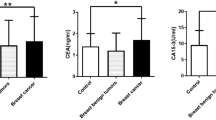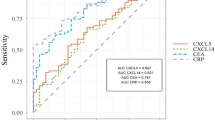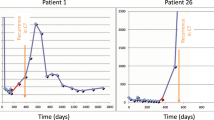Abstract
The usefulness of post-operatively serial serum CA15-3 determination with CEA and TPA was evaluated in a group of 285 breast cancer patients. In particular, the CA15-3 sensitivity to 'early' diagnosis and monitoring of the response to treatment of breast cancer relapses, was compared with those of the two other markers in order to define the most suitable association. Moreover, in a group of 169 non relapsed patients with a prolonged follow-up (40 +/- 8 months; mean +/- s.d.) CA15-3 specificity was investigated. During post-operative follow-up in 27 (10%) patients, distant metastases occurred. In most of them, elevated values of one or more tumour markers were the first pathological sign and CA15-3, CEA and TPA sensitivity to 'early' diagnosis of metastases were 46%, 7% and 63% respectively. When each tumour marker was considered in combination, CA15-3-CEA-TPA association showed a higher sensitivity (87%) than both CA15-3-TPA (83%) and the CEA-TPA (70%). Serum CA15-3 increase preceded the certain sign of metastases 2.7 +/- 2.6 months (mean +/- s.d.). Shortly before appearance and during treatment of distant metastases, constant elevation and/or progressive increase in serum CA15-3 values occurred in all evaluated patients except three in whom isolated elevated values were found as well. In 24 (14%) of 169 non relapsed patients with prolonged follow-up (40 +/- 8 months; mean +/- s.d.) high serum CA15-3 values occurred. In 16 of these 24 patients, an isolated elevated value was found, while four (2.3%) or the eight remaining ones with constant elevation and/or progressive increase were falsely suspected of metastases. In this group of non relapsed patients, chronic liver failure, diabetes and/or hepatic steatosis were the reasons more commonly responsible for the CA15-3 increase. In metastatic patients, no organ-specificity was shown either by CA15-3 or by CEA and TPA. In these patients serum TPA values showed the highest sensitivity and paralleled clinical and/or instrumental signs better than the CA15-3 and even more than CEA values. These data indicate that in the post-operative follow-up of breast cancer patients, TPA is the most useful tumour marker and TPA-CA15-3 the most suitable association. Contemporaneous measurement of serum CEA levels only slightly increases sensitivity and positive predictive value of TPA-CA15-3 combination.
This is a preview of subscription content, access via your institution
Access options
Subscribe to this journal
Receive 24 print issues and online access
$259.00 per year
only $10.79 per issue
Buy this article
- Purchase on Springer Link
- Instant access to full article PDF
Prices may be subject to local taxes which are calculated during checkout
Similar content being viewed by others
Author information
Authors and Affiliations
Rights and permissions
About this article
Cite this article
Nicolini, A., Colombini, C., Luciani, L. et al. Evaluation of serum CA15-3 determination with CEA and TPA in the post-operative follow-up of breast cancer patients. Br J Cancer 64, 154–158 (1991). https://doi.org/10.1038/bjc.1991.260
Issue Date:
DOI: https://doi.org/10.1038/bjc.1991.260
This article is cited by
-
Serum microRNA-21 as a potential diagnostic biomarker for breast cancer: a systematic review and meta-analysis
Clinical and Experimental Medicine (2016)
-
Early detection of metastatic disease in asymptomatic breast cancer patients with whole-body imaging and defined tumour marker increase
British Journal of Cancer (2015)
-
Kinetics of CEA and CA15-3 correlate with treatment response in patients undergoing chemotherapy for metastatic breast cancer (MBC)
Tumor Biology (2011)
-
Prognostic value of monitoring tumour markers CA 15-3 and CEA during fulvestrant treatment
BMC Cancer (2006)
-
Intensive post-operative follow-up of breast cancer patients with tumour markers: CEA, TPA or CA15.3 vs MCA and MCA-CA15.3 vs CEA-TPA-CA15.3 panel in the early detection of distant metastases
BMC Cancer (2006)



